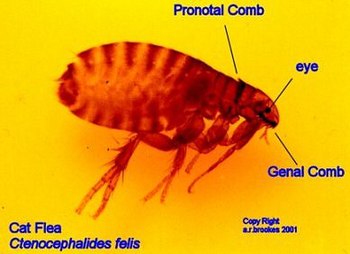 |
| (Photo credit: Wikipedia) |
They procreate in huge numbers which makes them next to - indestructible. Many times these fleas just become a nuisance other than anything else. Their small fish like structure goes unnoticed which makes it difficult to detect. Presence of pets in your house is another reason for fleas to attack humans. Having a spick and span environment keeps them off from your mattresses. The growth rate is so high that it becomes next to impossible to end the reign of terror. Some of the common effects fleabites have on us is a loss of hair, severe allergic reaction - rashes, itchy skin and severe diseases.
Home Remedies for Fleas
Keep your house clean by regular vacuuming as well as cleaning and bathing your pets to avoid any circulation of these parasites.
One of the most natural repellents which we have come across to fight fleas is the eucalyptus leaves. Somehow the smell is a major turn off for them.
You can use borax, which works great against the fleas. Spread it across your house; let it sit for some days and later vacuum your house to remove those fleas.
Spreading cedar chips along with your fence line or in your room can keep the fleas at bay. You can also have a tansy plant outside your dogs' pen to keep the fleas away.
Make garlic an important part of pets’ food. Mix it, crush it, mince it, powder it and use it in any form to keep the pest away from the pets.
Adding yeast pills to your dog's diet also gets rid of the fleas. These yeast pills can be easily found in any of the medical stores.
Try diatomaceous earth, is one of the most natural ways to get rid of fleas. It can be used be in your house, around the house and on your dog.
Warning: The reader of this article should exercise all precautionary measures while following instructions on the home remedies from this article. Avoid using any of these products if you are allergic to it. The responsibility lies with the reader and not with the site or the writer.



